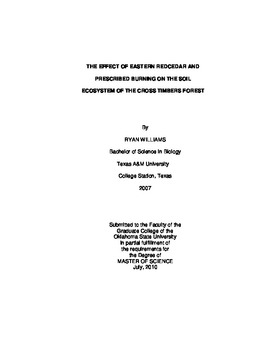| dc.contributor.author | Williams, Ryan | |
| dc.date.accessioned | 2014-04-15T22:00:03Z | |
| dc.date.available | 2014-04-15T22:00:03Z | |
| dc.date.issued | 2010-07-01 | |
| dc.identifier.uri | https://hdl.handle.net/11244/9203 | |
| dc.description.abstract | The purpose of this study was to explore the effect of two ecosystem factors, eastern redcedar (Juniperus virginiana) encroachment and prescribed burning, on the soil ecosystem of the Cross Timbers. I studied eight post oak (Quercus stellata) forests across central and western Oklahoma severely encroached by eastern redcedar. We sampled in areas dominated by eastern redcedar, post oak, and an even mix of both species. To determine the effect of prescribed burning on Cross Timbers soil, I studied stands burned with 0, 2.5 and 5 fires per decade (FPD). For both studies I analyzed litter nutrients, soil physiochemical properties, and soil microbial communities using phospholipid fatty acid analysis (PLFA). Forest stands dominated by eastern redcedar had a lower litter carbon concentration than post oak-dominated stands, while mixed stands had a lower litter nitrogen concentration than post oak-dominated stands. I did not observe any effect of tree species on soil physiochemical properties. Partial principle component analysis and partial redundancy analysis indicated differentiation of soil microbial community composition in stands of each species. Eastern redcedar stands had notably higher amounts of arbuscular mycorrhizae fungal (AMF) PLFA biomarkers than post oak stands. AMF has a symbiotic relationship with eastern redcedar and inhibits the growth of ectomycorrhizae that have a symbiosis with post oak. These differences illustrated the potential for eastern redcedar to alter nutrient cycling through litter quality and develop a competitive advantage over post oak due to its increasingly abundant fungal symbiont. In the prescribed burn study, I found that litter had a lower nitrogen concentration, higher C:N ratio, and higher lignin:N ratio with any burning. The 5 FPD treatment had a third of the soil organic carbon concentration and a lower abundance of gram negative bacteria than the 2.5 and 0 FPD units. Results suggested that any burning reduced litter nitrogen which could lead to slowed decomposition and a nitrogen-limited soil ecosystem. High frequency prescribed burning altered soil microbial communities through shifts in substrate and nutrient availability that could potentially alter biogeochemical cycling within the forest. | |
| dc.format | application/pdf | |
| dc.language | en_US | |
| dc.publisher | Oklahoma State University | |
| dc.rights | Copyright is held by the author who has granted the Oklahoma State University Library the non-exclusive right to share this material in its institutional repository. Contact Digital Library Services at lib-dls@okstate.edu or 405-744-9161 for the permission policy on the use, reproduction or distribution of this material. | |
| dc.title | Effect of Eastern Redcedar and Prescribed Burning on the Soil Ecosystem of the Cross Timbers Forest | |
| dc.type | text | |
| osu.filename | Williams_okstate_0664M_11014.pdf | |
| osu.college | Agricultural Sciences and Natural Resources | |
| osu.accesstype | Open Access | |
| dc.description.department | Department of Natural Resource Ecology and Management | |
| dc.type.genre | Thesis | |
| dc.subject.keywords | arbuscular mycorrhizal fungi | |
| dc.subject.keywords | cross timbers | |
| dc.subject.keywords | eastern redcedar | |
| dc.subject.keywords | oak | |
| dc.subject.keywords | plfa | |
| dc.subject.keywords | prescribed burning | |
